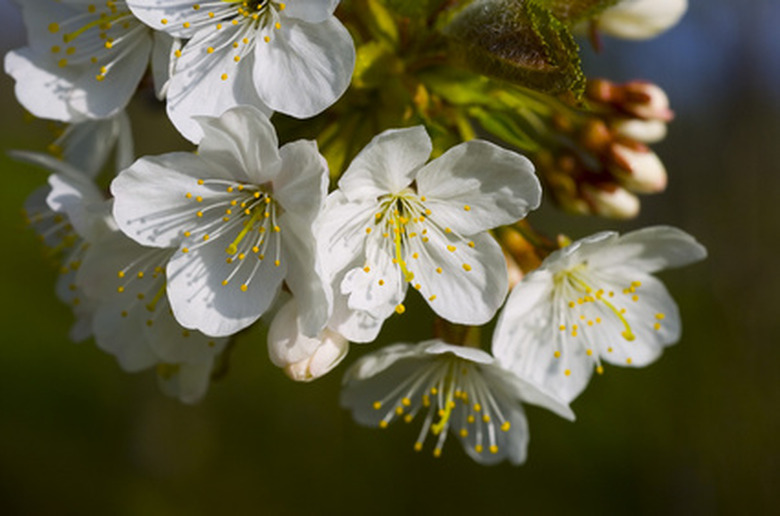How To Grow Cherry Trees In The Desert
Things Needed
- Shovel
- Bone meal
- Peat moss
- Mulch
- Nitrogen fertilizer
- Pruning shears
- Foliar leaf spray with minor elements
- Mycorrhizal fungi treatment
The cherry tree, a flowering deciduous tree that bears fruit, has both ornamental and nutritive value. Its attractive foliage and showy pink flowers in the spring make it a good specimen tree, and its harvest of juicy cherries make it a useful fruit tree. Cherry trees can grow in a desert climate if proper conditions are met. According to the Gardening in Arizona website, both sweet cherries–such as the Bing variety–and sour cherries–which include the Montmorency variety–are appropriate fruit trees to grow in Arizona's arid climate. By following good gardening guidelines for planting and aftercare, you can help your cherry tree to flourish.
Step 1
Select a site for your cherry tree in full sun and rich, well-drained soil with a pH between 6.0 and 6.8. Avoid areas where pockets of standing water may develop; cherry trees are susceptible to fungal root rot. Make sure there is room for at least two more cherry trees to grow, if you are growing sweet cherries; these are needed for cross-pollination and should be spaced 20 to 30 feet apart. If you are growing sour cherries, you don't need more than one tree. To avoid possible infection with fungal diseases like Verticillium wilt, make sure there were no fruit trees of any kind growing in the site in the past.
Step 2
Dig a hole twice as big around as the root ball, and about as deep. Sprinkle a handful of bone meal in the bottom of the planting hole to provide nutrients.
Step 3
Set the cherry tree in the hole, making sure it is centered and straight. Back-fill with the original garden soil into which you've added a few shovelfuls of peat moss, and tamp down. Water thoroughly.
Step 4
Apply a 2-inch layer of mulch to conserve water and protect the roots, but keep it at least 4 inches away from the trunk of the cherry tree.
Step 5
Water your cherry tree to keep the soil moist while the tree is establishing itself. As your cherry tree grows, water it deeply but not too frequently. Check the soil to a depth of 3 inches, and only water if it feels dry.
Step 6
Apply fertilizer to your cherry tree in the spring. According to the Colorado State University Cooperative Extension website, cherry trees should be fertilized at a maximum rate of 2 oz. of nitrogen per each inch of trunk diameter, as measured 12 inches above the ground. Spread the fertilizer in a circle around the tree, but don't let it touch the trunk.
Step 7
Prune your young cherry tree in the spring to help it develop a center leader. Reduce the surrounding branches to four main lateral limbs, or scaffolds, and shorten them by one-third. Try to develop a framework of well-spaced branches as the cherry tree grows older. Prune throughout the year for dead, diseased, damaged or crossed branches.
Step 8
Use a foliar–or leaf—fertilizer to provide minor elements such as boron, zinc and magnesium that may be missing from desert soil, and which your cherry tree needs.
Step 9
Use a mycorrhizal fungi treatment on your cherry tree. These beneficial fungi live in the tree's root system, and help to absorb water and nutrients.
